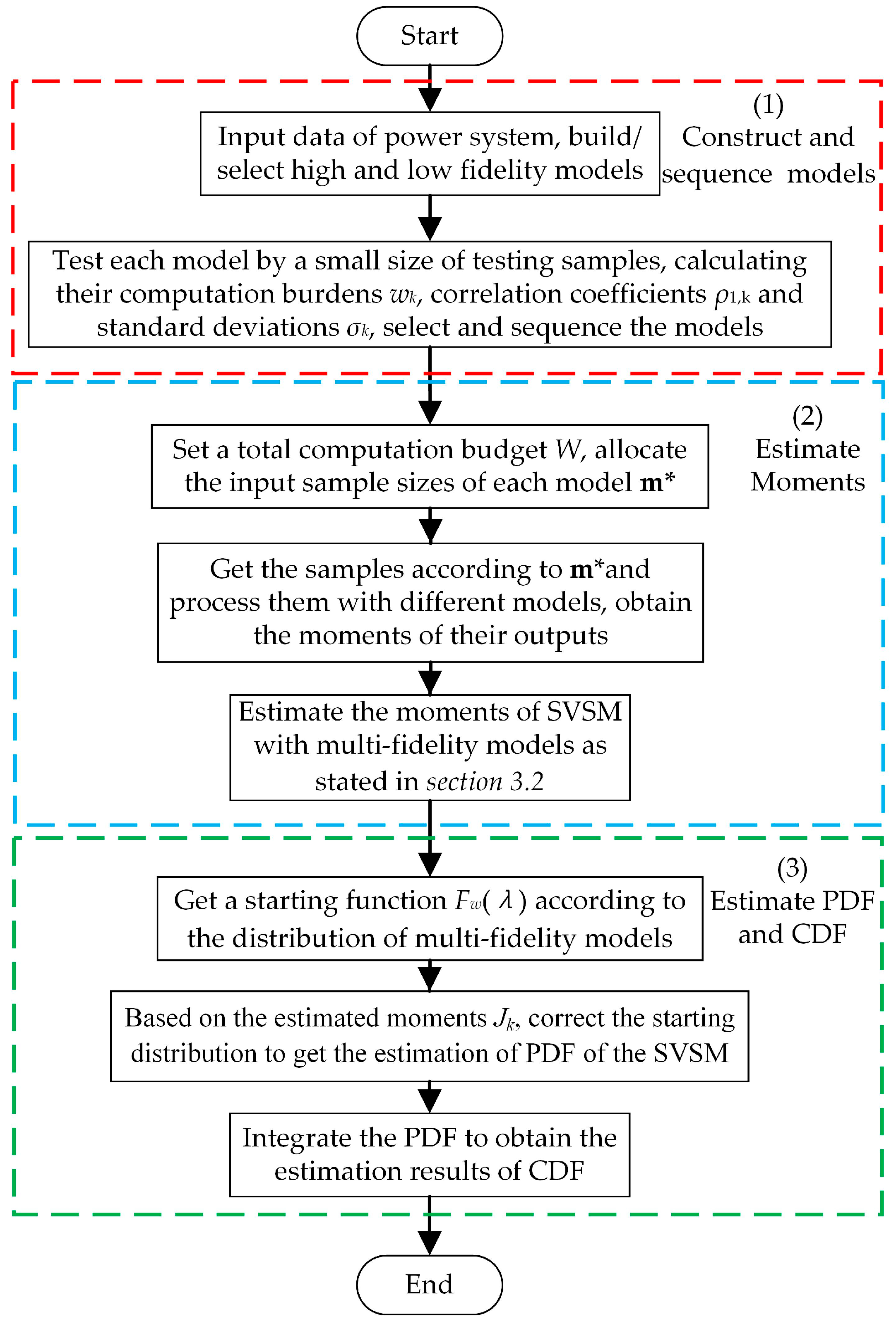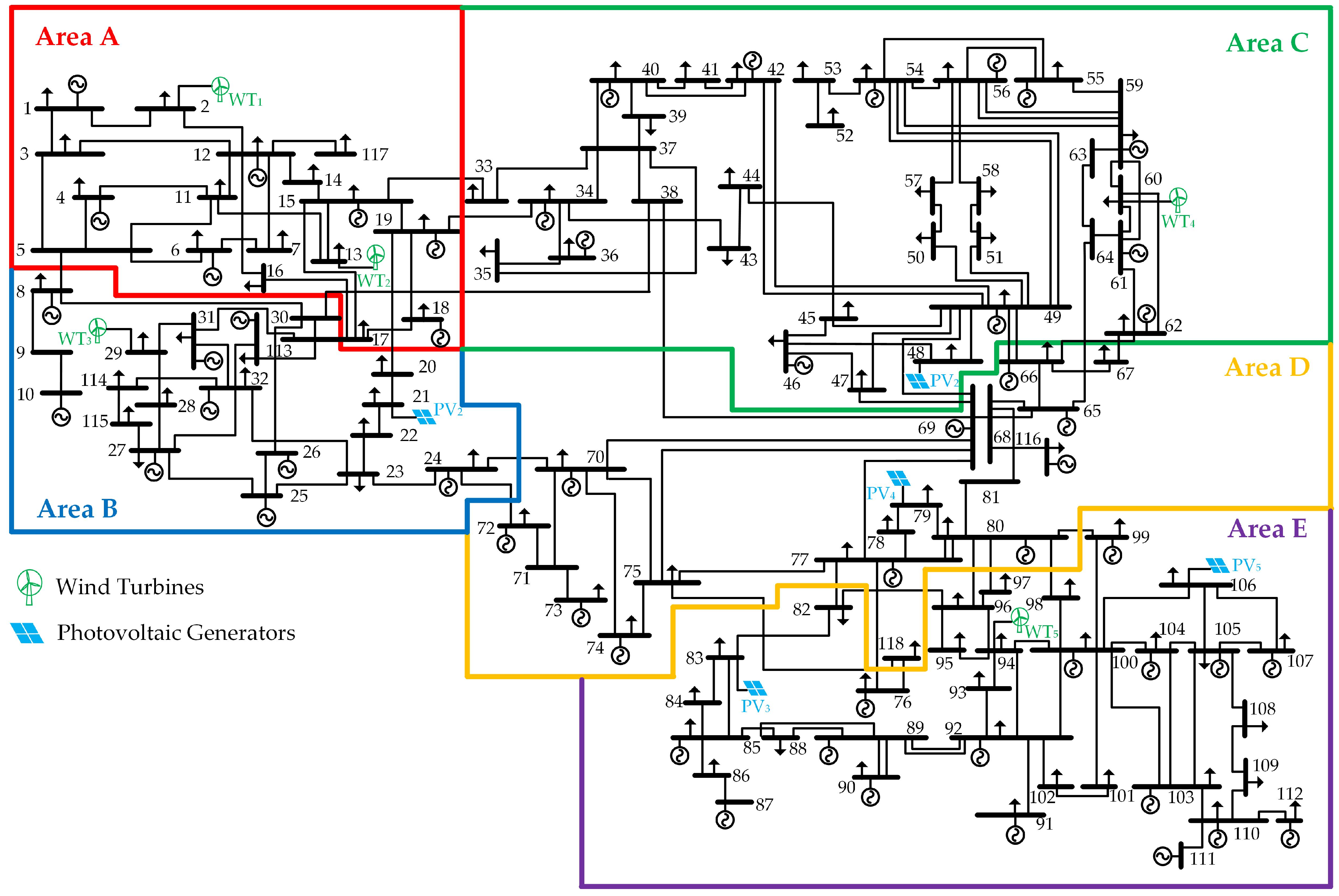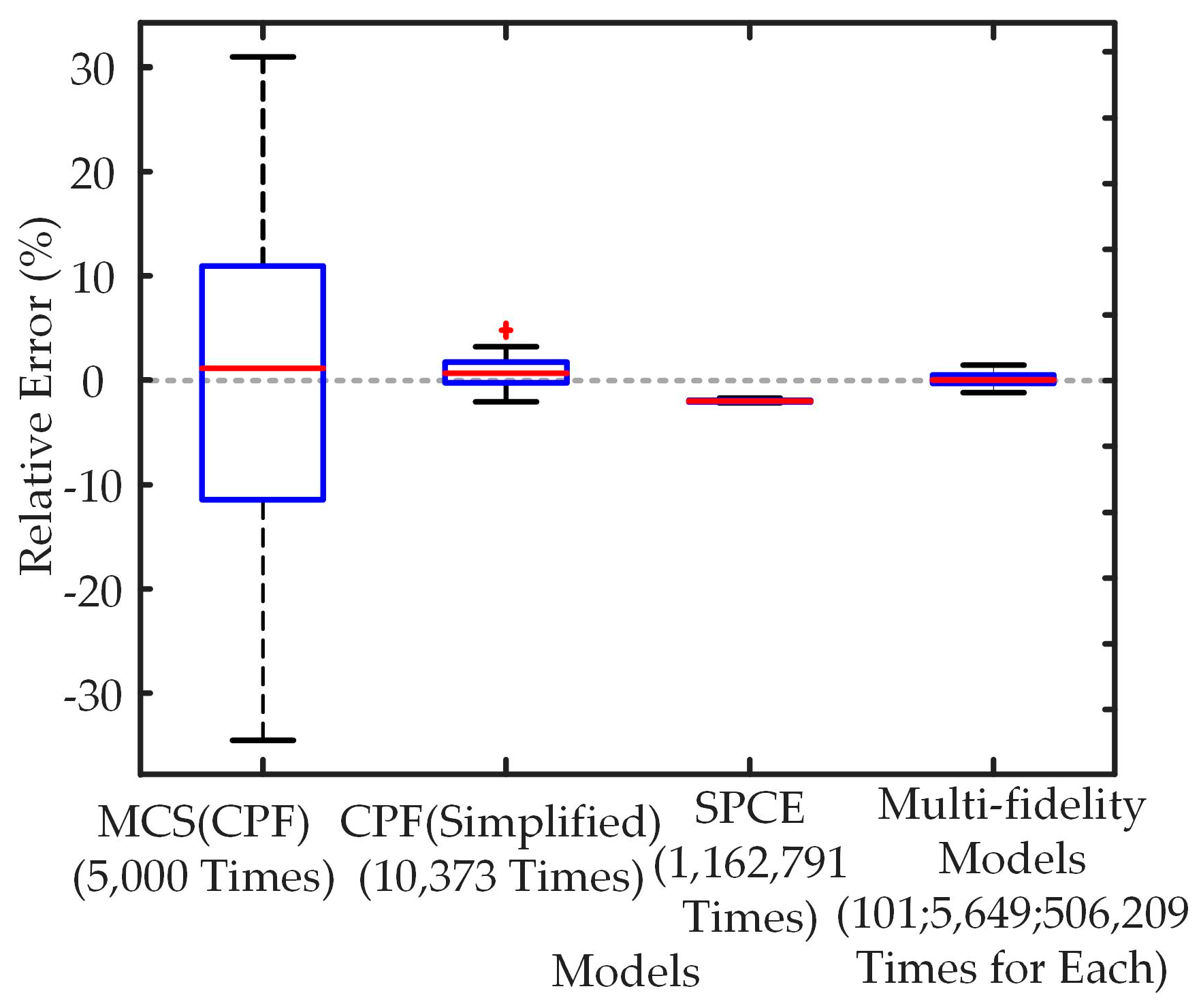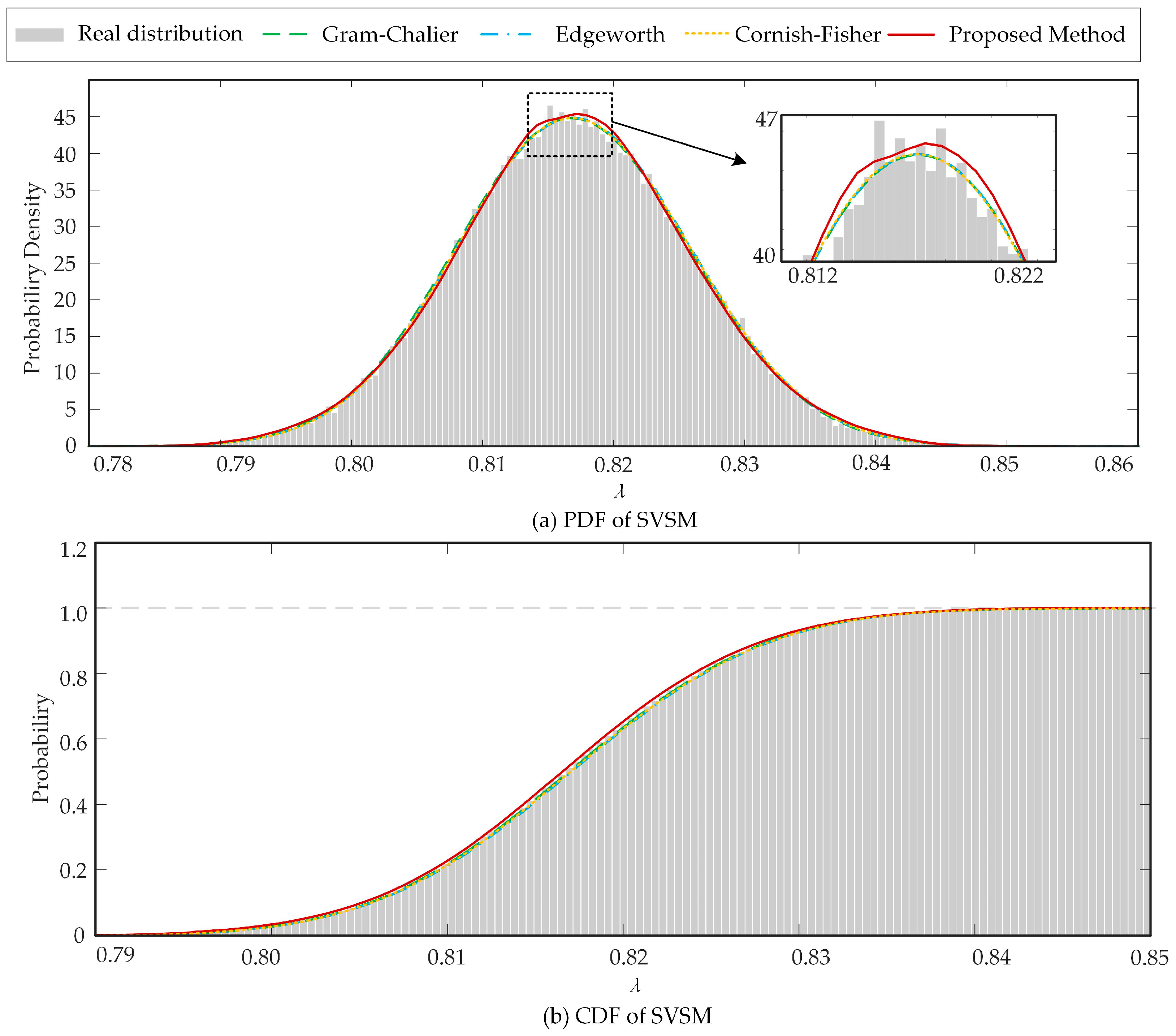Uncertainty Characterization Method of Static Voltage Stability Margin in Power Systems with High Percentage of Renewable Energy Based on the Multi-Fidelity Models
Abstract
1. Introduction
- The high-fidelity model-based methods establish a high-fidelity model for refined power flow computation and implement stochastic characterization using MCS. These types of methods can obtain accurate SVSM stochastic information but require a huge computational budget.
- Low-fidelity model-based methods, through approximation, linearization, proxy computation, etc., establish a low-fidelity model to fit the input–output relationship and finally obtain the approximate stochastic characteristics of the SVSM. These types of methods can significantly improve the computational efficiency of stochastic analysis, but they also introduce computational errors.
- High-fidelity models are difficult to balance efficiency and accuracy.
- 2.
- Low-fidelity models have inherent limitations on accuracy.
- A multi-fidelity-model-based stochastic SVSM analysis method is proposed to estimate the moments of SVSM. With the optimized sample size allocation between high- and low-fidelity models, the proposed method can obtain optimal SVSM estimation accuracy within a given computational budget. All the existing input–output SVSM estimation models are suitable for accelerating the calculation speed of this method, and it can achieve the same accuracy as the adopted high-fidelity model.
- A startup-function-based PDF fitting method is proposed to make full use of the moment evaluation results of SVSM and can achieve higher fitting accuracy and wider applicability compared to traditional level-expansion methods.
2. Stochastic SVSM Analysis Model
2.1. Model Availability for the Multi-Fidelity Model Method
2.2. Calculation of SVSM
2.3. SVSM Analysis with Source–Load Uncertainty Model
- The WT model based on Weibull distribution of wind speeds
- 2.
- The PVG model based on the Beta distribution of solar irradiance
- 3.
- Load model based on normal distribution
3. Stochastic SVSM Analysis Method Based on Multi-Fidelity Models
3.1. Basic Assumptions and Scope of Application
3.2. Abstract Model for SVSM Analysis
3.3. Moment Estimation of SVSM with Multi-Fidelity Models
3.3.1. Mean Estimation with Multi-Fidelity Models
- Determine the model sequence (f(1), f(2),…, f(K))
- 2.
- Determine the sample size sequence m* and the control coefficient αk
- Unbiasedness of Mean Estimation
- 2.
- Optimal Sample Size Allocation with Minimum Deviation from Mean Estimation
3.3.2. L-Order Moment Estimation with Multi-Fidelity Models
3.4. PDF Estimation with Moment Results and the Starting Distribution Method
3.5. Applicability of the Proposed Multi-Fidelity Model Method
- Accurate Estimation of the Moment and PDF of SVSM
- 2.
- Match flexible time scales for power system operation analysis
4. Procedure of the Proposed Method
- Construct and sequence the high- and low-fidelity models
- 2.
- Estimate the moments of the SVSM
- 3.
- Estimate the PDF and CDF of the SVSM
5. Case Studies
5.1. Case Introduction
5.2. Results of Mean Estimation
5.2.1. Comparison of Accuracy with High-, Low-, and Multi-Fidelity Models
- With an increasing total computational budget, the gaps between the estimation results and the true moments of λ with high-, low-, and multi-fidelity models all have a decreasing tendency; however, when the given computational budget exceeds a certain value (e.g., 103 MCSs), the MSEs of the low-fidelity models (CPF(Simplified), SPCE) remain almost unchanged, while the MSEs of the high-fidelity (MCS(CPF)) and MFM estimation results can still continue to decrease as before. This indicates that the low-fidelity model is biased with inherent systematic bias, and its computational accuracy has an upper limit when the calculation number is large enough, while the MFM is able to maintain the same unbiasedness as the high-fidelity model, and the estimation results can keep converging to the benchmark value with the increase in computational budget.
- Compared to using only a high-fidelity model, the proposed MFM method has a smaller MSE (1~2 orders of magnitude accuracy advantage in this case) under the same computational budget, indicating that the proposed method effectively improves computational accuracy while ensuring unbiasedness.
- Compared to the low-fidelity model, the MSE of the computational results of the MFMs is not much different from that of the low-fidelity model when the computational burden is small (e.g., less than 102 MCSs), but as the computational burden increases, the computational accuracy of the MFM will be better than that of the low-fidelity model.
- For variance and higher-order moments, although the optimality of input sample size allocation cannot be guaranteed, the MFM method can also effectively improve the calculation’s accuracy, which is better than that of the high-fidelity model under the same computational burden. This shows the applicability of this sample size allocation to estimating higher-order moments.
- Both of the MSE curves of MFM method with different MFM sequences are under the curve of the high-fidelity model (MCS(CPF)), indicating that introducing low-fidelity models can effectively increase the computation stability of the SVSM evaluation with the proposed method.
- The MSE curve of the MFM sequence with two models is almost above that of three models, meaning that the SVSM evaluation stability becomes better with an additional low-fidelity model (CPF(Simplified)), which is consistent with the previous predictions using Equation (16).
5.2.2. Comparison of Stability with High-, Low-, and Multi-Fidelity Models
- The errors of both the MFM and the high-fidelity model (MCS(CPF)) fluctuate around 0, but the fluctuation range of the error distribution of the MFM is smaller in comparison; this indicates that although both are unbiased estimators, the error fluctuation of the results obtained from the MFMs is smaller and the stability of this method is better.
- The error distribution of the low-fidelity model (especially SPCE) is concentrated, but the range of its distribution is somewhat different from 0; this indicates that there is an inherent systematic bias in the computation of the low-fidelity models, and their accuracy cannot be guaranteed by increasing the calculation number, even though if results are very stable.
5.3. Results of the Probabilistic Distribution Estimation
- Comparison of the estimation results from single the model and the proposed method
- 2.
- Comparison of the estimation results of the level expansion methods and the proposed method
6. Conclusions
- Compared to the high-fidelity model (MCS, in the studied case), the proposed MFM method can keep 1~2 orders of magnitude accuracy advantage over the high-fidelity model at the MSE of SVSM moment evaluation, while keeping the same MSE descending speed as the high-fidelity model when the computational budget increases. This indicates that this method can compensate for the efficiency and accuracy of the calculation of stochastic SVSM and obtain the SVSM moment evaluation results with the same accuracy as the high-fidelity model, while accelerating the computation speed with the low-fidelity models.
- Compared to the low-fidelity models (CPF(Simplified), SPCE), the proposed MFM method exhibits sustained MSE reduction proportional to increased computational budget allocation. This diverges fundamentally from low-fidelity approaches that encounter inherent accuracy ceilings due to structural limitations. The persistent convergence behavior demonstrates the method’s statistical consistency and numerical stability, enabling superior moment estimation accuracy for stochastic SVSM compared to standalone low-fidelity models.
- For the estimation of PDF and CDF of SVSM, under constrained computational budgets (1000 MCS equivalent evaluations), the proposed startup function-based fitting method outperforms both individual models (high- and low-fidelity) and conventional-level expansion techniques in PDF/CDF reconstruction, with the benchmark derived from many more evaluations of the high-fidelity model (106 MCS evaluations). This indicates that the proposed method can fit the SVSM distribution better with a lower computational budget than the other investigated methods, while achieving performance similar to the high-fidelity model for large sample evaluations.
Author Contributions
Funding
Data Availability Statement
Acknowledgments
Conflicts of Interest
Appendix A
| No. | Beta Distribution Parameters | Wind Turbine Parameters | ||||
|---|---|---|---|---|---|---|
| Shape Parameter | Scale Parameter | vin/ (m/s) | vout/ (m/s) | vN/ (m/s) | PN/ kW | |
| 1 | 3.0 | 7.5 | 3.5 | 20.0 | 14.5 | 600 |
| 2 | 2.0 | 7.0 | 3.0 | 19.0 | 13.0 | 600 |
| 3 | 2.5 | 6.0 | 3.5 | 20.0 | 15.5 | 600 |
| 4 | 2.5 | 7.5 | 3.0 | 18.5 | 13.0 | 750 |
| 5 | 3.0 | 6.0 | 3.5 | 19.0 | 14.0 | 750 |
| No. | Beta Distribution Parameters | PV Cell Parameters | ||
|---|---|---|---|---|
| ξa | ξb | A/m2 | η/% | |
| 1 | 0.40 | 8.56 | 25,200 | 15 |
| 2 | 0.45 | 9.81 | 19,800 | 14 |
| 3 | 0.50 | 8.94 | 24,375 | 16 |
| 4 | 0.40 | 8.56 | 25,200 | 15 |
| 5 | 0.45 | 9.81 | 19,800 | 14 |
References
- Yun, Z.; Cui, X. Online preventive control method for static voltage stability of large power grids. IEEE Trans. Power Syst. 2020, 35, 4689–4698. [Google Scholar]
- Fan, Y.; Liu, S.; Qin, L.; Li, H.; Qiu, H. A novel online estimation scheme for static voltage stability margin based on relationships exploration in a large data set. IEEE Trans. Power Syst. 2014, 30, 1380–1393. [Google Scholar]
- Wang, Q.; Lin, S.; Yang, Y.; Liu, M. A decomposition and coordination algorithm for SVSM interval of integrated transmission and distribution networks considering the uncertainty of renewable energy. Int. J. Electr. Power Energy Syst. 2022, 136, 107761. [Google Scholar]
- Van Cutsem, T.; Vournas, C. Voltage Stability of Electric Power Systems, 1st ed.; Kluwer Academic Publishers: Dordrecht, The Netherlands, 1998; p. 188. [Google Scholar]
- Rodrigues, A.B.; Prada, R.B.; da Silva, M.D.G. Voltage stability probabilistic assessment in composite systems: Modeling unsolvability and controllability loss. IEEE Trans. Power Syst. 2010, 25, 1575–1588. [Google Scholar]
- Liu, K.Y.; Sheng, W.; Hu, L.; Liu, Y.; Meng, X.; Jia, D. Simplified probabilistic voltage stability evaluation considering variable renewable distributed generation in distribution systems. IET Gener. Transm. Distrib. 2015, 9, 1464–1473. [Google Scholar]
- Xie, Y.; Lin, S.; Liang, W.; Yang, Y. Interval Probabilistic Energy Flow Calculation of CCHP Campus Microgrid Considering Interval Uncertainties of Distribution Parameters. IEEE Access 2020, 8, 141358–141372. [Google Scholar]
- Kiefer, J. On large deviations of the empiric DF of vector chance variables and a law of the iterated logarithm. Pacific J. Math. 1961, 11, 649–660. [Google Scholar] [CrossRef][Green Version]
- Yu, H.; Chung, C.Y.; Wong, K.P.; Lee, H.W.; Zhang, J.H. Probabilistic load flow evaluation with hybrid latin hypercube sampling and cholesky decomposition. IEEE Trans. Power Syst. 2009, 24, 661–667. [Google Scholar]
- Bratley, P.; Fox, B.L. Algorithm 659: Implementing Sobol’s quasirandom sequence generator. ACM Trans. Math. Softw. (TOMS) 1988, 14, 88–100. [Google Scholar]
- Saunders, C.S. Point estimate method addressing correlated wind power for probabilistic optimal power flow. IEEE Trans. Power Syst. 2013, 29, 1045–1054. [Google Scholar]
- Zhang, P.; Lee, S.T. Probabilistic load flow computation using the method of combined cumulants and Gram-Charlier expansion. IEEE Trans. Power Syst. 2004, 19, 676–682. [Google Scholar]
- Moreira, E.; Chagas, E.; Rodrigues, A.; da Silva, M.D.G. Linear probabilistic power flow for islanded microgrids. In Proceedings of the 2020 International Conference on Probabilistic Methods Applied to Power Systems (PMAPS), Liege, Belgium, 18–21 August 2020; IEEE: New York, NY, USA; pp. 1–6. [Google Scholar]
- Jiang, Y.; Ren, Z.; Sun, Z.; Li, W.; Yang, X. A stochastic response surface method based probabilistic energy flow analysis method for integrated electricity and gas systems. IEEE Trans. Power Syst. 2022, 37, 2467–2470. [Google Scholar]
- Ni, F.; Nguyen, P.H.; Cobben, J.F. Basis-adaptive sparse polynomial chaos expansion for probabilistic power flow. IEEE Trans. Power Syst. 2016, 32, 694–704. [Google Scholar]
- Wu, H.; Zhou, Y.; Dong, S.; Xin, H.; Song, Y. Probabilistic load flow by generalized polynomial chaos method. In Proceedings of the 2016 IEEE Power and Energy Society General Meeting (PESGM), Boston, MA, USA, 17–21 July 2016; IEEE: New York, NY, USA; pp. 1–5. [Google Scholar]
- Aien, M.; Fotuhi-Firuzabad, M.; Aminifar, F. Probabilistic load flow in correlated uncertain environment using unscented transformation. IEEE Trans. Power Syst. 2012, 27, 2233–2241. [Google Scholar]
- Wu, H.; Zhou, Y.; Dong, S.; Song, Y. Probabilistic load flow based on generalized polynomial chaos. IEEE Trans. Power Syst. 2016, 32, 820–821. [Google Scholar]
- Amid, P.; Crawford, C. A cumulant-tensor-based probabilistic load flow method. IEEE Trans. Power Syst. 2018, 33, 5648–5656. [Google Scholar]
- Khatami, R.; Parvania, M. Stochastic multi-fidelity scheduling of flexibility reserve for energy storage. IEEE Trans. Sustain. Energy 2020, 11, 1438–1450. [Google Scholar]
- Zhang, Y.; Li, Y.; Qiu, F.; Hong, T.; Markel, L. Learning frequency nadir from multi-fidelity data for dynamic secure microgrid islanding. In Proceedings of the 2022 IEEE Power & Energy Society General Meeting (PESGM), Denver, CO, USA, 17–21 July 2022; pp. 1–5. [Google Scholar]
- Zhu, B.; Ren, S.; Wei, Z.; Si, F. Transfer learning-based multi-fidelity modeling method for multimode process monitoring. In Proceedings of the 2024 IEEE 4th International Conference on Digital Twins and Parallel Intelligence (DTPI), Wuhan, China, 18–20 October 2024; pp. 465–470. [Google Scholar]
- Yang, S.; Vaagensmith, B.; Patra, D.; Hruska, R.; Phillips, T. Multi-fidelity power flow solver. In Proceedings of the 2022 Resilience Week (RWS), National Harbor, MD, USA, 26–29 September 2022; pp. 1–6. [Google Scholar]
- Ye, K.; Pei, Y.; Zhao, J.; Yao, Y.; Wang, J.; Ding, F. Multi-fidelity learning for distribution system voltage probabilistic analysis with high penetration of PVs. In Proceedings of the 2022 IEEE Power & Energy Society General Meeting (PESGM), Denver, CO, USA, 17–21 July 2022; pp. 1–5. [Google Scholar]
- Ajjarapu, V.; Christy, C. The continuation power flow: A tool for steady state voltage stability analysis. IEEE Trans. Power Syst. 1992, 7, 416–423. [Google Scholar]
- Xu, X.; Yan, Z.; Shahidehpour, M.; Wang, H.; Chen, S. Power system voltage stability evaluation considering renewable energy with correlated variabilities. IEEE Trans. Power Syst. 2017, 33, 3236–3245. [Google Scholar]
- Chen, Y.; Wen, J.; Cheng, S. Probabilistic load flow method based on Nataf transformation and Latin hypercube sampling. IEEE Trans. Sustain. Energy 2012, 4, 294–301. [Google Scholar]
- Fan, M.; Li, Z.; Ding, T.; Huang, L.; Dong, F.; Ren, Z.; Liu, C. Uncertainty evaluation algorithm in power system dynamic analysis with correlated renewable energy sources. IEEE Trans. Power Syst. 2021, 36, 5602–5611. [Google Scholar] [CrossRef]
- Bay, Y.D.; Suvorov, A.A.; Gusev, A.S.; Razzhivin, I.A.; Askarov, A.B. Stochastic modeling of a DFIG wind turbine in Matpower. IEEE Access 2021, 9, 76005–76014. [Google Scholar] [CrossRef]
- Obadina, O.O.; Berg, G.J. Determination of voltage stability limit in multimachine power systems. IEEE Trans. Power Syst. 1988, 3, 1545–1554. [Google Scholar] [CrossRef]
- Canizares, C.A.; Alvarado, F.L. Point of collapse and continuation methods for large AC/DC systems. IEEE Trans. Power Syst. 1993, 8, 1–8. [Google Scholar] [CrossRef]
- Villanueva, D.; Pazos, J.L.; Feijoo, A. Probabilistic load flow including wind power generation. IEEE Trans. Power Syst. 2011, 26, 1659–1667. [Google Scholar] [CrossRef]
- Peherstorfer, B.; Willcox, K.; Gunzburger, M. Optimal model management for multifidelity Monte Carlo estimation. SIAM J. Sci. Comput. 2016, 38, A3163–A3194. [Google Scholar] [CrossRef]
- Qian, E.; Peherstorfer, B.; O’Malley, D.; Vesselinov, V.V.; Willcox, K. Multifidelity Monte Carlo estimation of variance and sensitivity indices. SIAM/ASA J. Uncertain. Quantif. 2018, 6, 683–706. [Google Scholar] [CrossRef]
- Fan, M.; Vittal, V.; Heydt, G.T.; Ayyanar, R. Probabilistic power flow studies for transmission systems with photovoltaic generation using cumulants. IEEE Trans. Power Syst. 2012, 27, 2251–2261. [Google Scholar] [CrossRef]
- Tekel, J.; Cohen, L. Constructing and estimating probability distributions from moments. In Proceedings of the Automatic Target Recognition XXII, Baltimore, MD, USA, 23–24 April 2012; SPIE: Bellingham, WA, USA; Volume 8391, pp. 114–123. [Google Scholar]
- Li, S.H.; Chiang, H.D. Nonlinear predictors and hybrid corrector for fast continuation power flow. IET Gener. Transm. Distrib. 2008, 2, 341–354. [Google Scholar] [CrossRef]









| Model | Time for 500 Calculations (s) | Computation Burden (Times of MCS) |
|---|---|---|
| MCS(CPF) | 11.27 | 1.0000 |
| CPF(Simplified) | 5.43 | 0.4820 |
| SPCE | 0.04 | 0.0043 |
| Models | Correlation Coefficients ρ1,k | Mean of Outputs Ek | Variance of Outputs σk2 | Input Sample Sizes |
|---|---|---|---|---|
| MCS(CPF) | 1.000000 | 0.8169392 | 7.918803 × 10−5 | 203 |
| CPF(Simplified) | 0.999954 | 0.8239151 | 7.774890 × 10−5 | 11,303 |
| SPCE | 0.993071 | 0.8169068 | 7.998040 × 10−5 | 1,011,582 |
| Order of Origin Moment k | Jk(λ) | Order of Origin Moment k | Jk(λ) |
|---|---|---|---|
| 1 | 0.8169 | 4 | 0.4457 |
| 2 | 0.6675 | 5 | 0.3643 |
| 3 | 0.5454 | 6 | 0.2978 |
Disclaimer/Publisher’s Note: The statements, opinions and data contained in all publications are solely those of the individual author(s) and contributor(s) and not of MDPI and/or the editor(s). MDPI and/or the editor(s) disclaim responsibility for any injury to people or property resulting from any ideas, methods, instructions or products referred to in the content. |
© 2025 by the authors. Licensee MDPI, Basel, Switzerland. This article is an open access article distributed under the terms and conditions of the Creative Commons Attribution (CC BY) license (https://creativecommons.org/licenses/by/4.0/).
Share and Cite
Wang, Y.; Yu, L.; Zhao, Z.; Wang, H.; Xie, J.; Zhang, L. Uncertainty Characterization Method of Static Voltage Stability Margin in Power Systems with High Percentage of Renewable Energy Based on the Multi-Fidelity Models. Energies 2025, 18, 1614. https://doi.org/10.3390/en18071614
Wang Y, Yu L, Zhao Z, Wang H, Xie J, Zhang L. Uncertainty Characterization Method of Static Voltage Stability Margin in Power Systems with High Percentage of Renewable Energy Based on the Multi-Fidelity Models. Energies. 2025; 18(7):1614. https://doi.org/10.3390/en18071614
Chicago/Turabian StyleWang, Yanhong, Limin Yu, Ziheng Zhao, Han Wang, Jinghua Xie, and Lin Zhang. 2025. "Uncertainty Characterization Method of Static Voltage Stability Margin in Power Systems with High Percentage of Renewable Energy Based on the Multi-Fidelity Models" Energies 18, no. 7: 1614. https://doi.org/10.3390/en18071614
APA StyleWang, Y., Yu, L., Zhao, Z., Wang, H., Xie, J., & Zhang, L. (2025). Uncertainty Characterization Method of Static Voltage Stability Margin in Power Systems with High Percentage of Renewable Energy Based on the Multi-Fidelity Models. Energies, 18(7), 1614. https://doi.org/10.3390/en18071614





